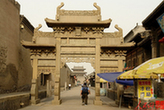The Eagle and Pine. |
Xu Beihong (1895-1953), noted painter and educator in the fine arts, played an important role in the development of Chinese art in the 20th century. Today, his work is still highly venerated, and in October this year his 1936 painting The Eagle and Pine fetched HK $21.275 million, about US $2.75 million, at an auction held by China Guardian in Hong Kong.
Xu painted The Eagle and Pine when he was 41 years old for He Jian, then chairman of Hunan province. The painting is a superb example of Mogu, a “boneless” style popular for landscapes and pictures of birds and flowers, in which the artist applies colors directly to the paper without outlines. It shows an eagle, midair with its wings spread, above a twisting pine branch. Xu uses various techniques which are sometimes precise and realistic and at others more impressionistic, that bring the spirit and movement of the bird to life. Its plumage is leaf-like, each brushstroke a suggestion, whereas its piercing eye, glaring side on at the onlooker, has a darker, more detailed quality that draws the attention. The image of the eagle, here representing soaring aspirations, is one that Chinese painters have an abiding fondness for. Few, however, can capture its essence as Xu did in this painting.
Xu studied Chinese poems, essays, calligraphy and painting with his father from a young age. By the time he was 17 he was accomplished enough to become an art teacher in Jiangsu province’s Yixing city. In 1916, Xu entered Fudan University in Shanghai to study French, supporting himself with part-time jobs, and independently, studying drawing in his spare time. The following year he went to Japan to study art and in 1919 traveled to the École Nationale Supérieure des Beaux-Arts in Paris, where he studied oil painting and drawing. He spent the best part of a decade in Western Europe, observing and appreciating Western art.
A Galloping Horse |





Why not rent a boyfriend, or girlfriend to please parents during the Spring Festival?